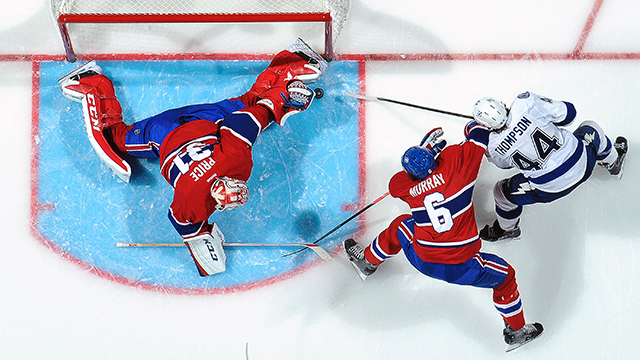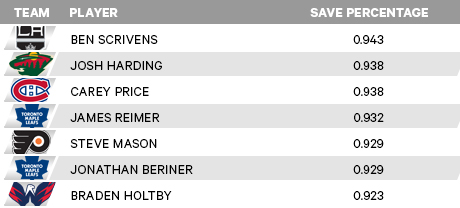I have noticed a pattern that has emerged recently that helps to explain seemingly unexplainable goaltending results. When goaltenders like Mike Smith, Ben Scrivens or Michael Leighton go on bafflingly dominant runs, the media goes through some simple progressions. Step one is to identify what’s different. Sometimes it’s a new team, but often it’s a new goaltending coach. Step two is to seek out expert opinion to identify the roots of the improvement. And step three is an assessment of what minor adjustment the goaltending coach has made.
The problem is the more that progression is relied upon, the more examples of data contradicting it can be found. In 2009-10, Leighton’s rise was credited to improved lateral mobility. But after leading the Philadelphia Flyers to the Stanley Cup Final, he has played two NHL games. Smith and Sean Burke become linked when, out of nowhere, Smith registered a .930 save percentage in 2011-12. Since then, he has been below league average. Ben Scrivens is the most recent focus of this type of analysis.
I will not dispute that Burke has tweaked and improved Smith’s game, but the degree of his impact is what is in question. If Smith’s corrected flaws were responsible for his statistical leap, why has he registered a league-average save percentage this season and last? Two weekends ago the same trope was trotted out on CBC when discussing Stephane Waite and his impact on Carey Price in Montreal. Waite, to his credit, downplayed the right things and addressed something I personally complained about in regards to Price’s love of the reverse VH last season—a poor save selection if overused, though it didn’t stop Tim Thomas and Jonathan Quick from relying on it heavily to win back-to-back Conn Smythe Trophies in 2011 and ’12
I don’t doubt that Waite is a good goalie coach, but you can’t paint the ceiling of the Sistine Chapel with your fingers, and Waite can’t craft elite goaltending results with small technical adjustments. If he could, then there would be a history of him doing so during his time in Chicago.
Since the lockout Waite’s goaltenders have been below the league average in six of eight seasons—three of those coming when the Blackhawks were among the league’s best teams. Focusing solely on Corey Crawford, he has been exactly league average with .913 save percentage through 4,000 shots.
A better explanation for Price’s statistical improvements could be better defensive coverage in front of him. Three weeks ago, I contrasted Price’s workload vs. Tuukka Rask’s and concluded that shot quality was a definitive factor in Rask sustaining an elite save percentage, and if Price had similar defensive support his save percentage would respond in kind. When comparing Price’s 2013-14 workload vs. Rask’s 2012-13, we don’t see a huge difference. Really, it comes down to 11 high-quality rebound shots per 1,000 shots. Price has close to an .800 save percentage on rebound shots during his career, so we are talking a two-goal expected difference for just over a half season.
One of the things that has pushed Price’s save percentage through the roof this season is his .973 mark on clean shots. When this normalizes (And it will. Craig Anderson had a .980 last season through 24 games, this season he has fallen well back.) Price will drop from the high .930s. If he continues to get the defensive support he has through the first two months, then he should be able to stay among the league leaders. Another explanation is an overreaction to the small sample of the lockout-shortened campaign. During Price’s six-season career, he has averaged 1,672 shots against. If I combine my samples from 2012-13 and 2013-14 (I have tracked Price’s starts through Dec. 1) I get 1,670 shots. The result? A .917 save percentage. Price’s career save percentage? .916.
Better defence in front of him and a shortened 2012-13 season seem like more realistic explanations for Price’s success. When tasked with trying to explain the unexplainable while lacking a true understanding of the goaltending position, seeking out an expert is a logical decision—99.9 percent of the population would find it better than doing something crazy like tracking every game. I chose the crazy route and with it can provide otherwise unavailable context. Unfortunately fans and media are slaves to save percentage. Even worse, they are slaves to save percentage without context. It is how we can move in such extreme directions in regards to our goaltending opinions.
We are three months removed from “Who the hell is Canada going to start in goal in Sochi?” to Canada having multiple candidates because of hot starts in small samples. Look at the save percentage leaderboard.
Who will Canada start in Sochi is an interesting question. One that the Shot Quality Project will tackle next week as I examine the contenders and offer context to provide some help for Steve Yzerman as we approach the Jan. 7 roster deadline.




